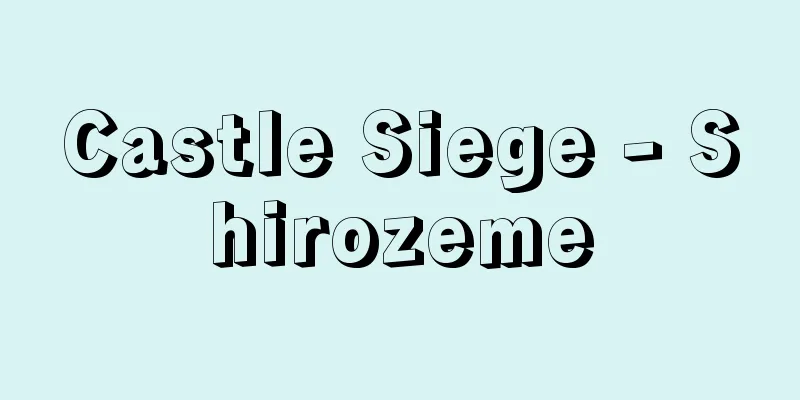Castle Siege - Shirozeme

|
A tactic of directly attacking a castle is called a castle siege, and there are many examples of this from the primitive age to the early modern period. Traces of castle siege battles have been discovered one after another in castle ruins from the Yayoi period, known as highland settlements and moated settlements. Under the ancient Yamato government, castles were used as bases for rebellions in the Tohoku region, and castles such as Akita Castle in the Dewa Fushu Rebellion (878), Toriumi Castle and Kuriyagawa Castle in the Zen Nine Years' War (1051-62), and Kanazawa Castle in the Gosannen War (1083-87) were the sites of castle sieges. In the Middle Ages, from the end of the Kamakura period through the period of conflict between the Northern and Southern Courts, the main forms of warfare were sieges, in which people barricaded themselves inside castles, and sieges, in which people attacked those castles. The style of battle in the Kamakura period, typified by the conflicts between warriors, was a field battle between warrior classes competing in martial arts, but soon, due to the contradictions of the manor and public land system, a new class of people who had left the farming world formed gangs and barricaded themselves in mountain castles. From among them appeared mercenaries called ashigaru, and group and guerrilla warfare spread, replacing the samurai tactics of single combat. Thus, we see a progression of confrontations: construction of mountain castles → rampages in the fields → sieges → obedience to the law, and gangsterism and mountain castles became two sides of the same coin. During the period of conflict between the Northern and Southern Courts, mountain castles were used by the Southern Court army, and as ashigaru were organized and guerrilla warfare became common, tactics were added to martial arts, which marked a turning point in which many ideas were created for castle offensives and defensive battles. The famous battles of Kasagiyama Castle, Akasaka Castle, Chihaya Castle, Senjosan Castle, and Ryozen Castle occurred when the Southern Court side barricaded themselves in mountain castles at the tip of steep mountain ranges and fought against the Ashikaga forces. In the Muromachi period, shugo daimyo and other feudal lords built magnificent mountain castles with attached residences, which became bases for controlling the region. In the Kanto plains, castles were built on tongue-shaped hills and plateaus. Representative sieges of castles from this period include the attack on Oyama Castle during the Oyama Rebellion (1380), the Battle of Yuki Castle (1440-41) that followed the Eikyou Rebellion (1438), and the battle between Akamatsu Mitsusuke, who was holed up in Harimaki Castle, and the Ashikaga Shogunate forces that attacked him during the Kakitsu Rebellion (1441). During the Onin War (1467-77), many jinjiro (camp castles), which were fortifications built in preparation for war, were built in Kyoto City, and the battle for the castles became the focus of attention. In particular, the Hekizan Nichiroku and Yamashina Keraiki records that well towers and stone arrows were frequently installed in the castles. Well towers are assembled towers, some of which were over 10 meters long (over 30 meters). Stone arrows are a primitive form of cannon that fires large stones using gunpowder. At the same time, a great conflict broke out in the Kanto region over the position of steward for the Kanto Kanrei family. More than 30 battles took place in what became known as the Nagao Kageharu Rebellion, during which the rebel forces were besieged by Ota Dokan. Dokan is said to have used foot soldiers tactics, organized his foot soldiers, and used jinjō (camp castles) to attack enemy castles, capturing a total of 21 castles. He built his own castle, Edo Castle, using a method of castle construction (castle construction and plans) known as Dokan-gakari, making it a very strong fortress. In October 1491 (Entoku 3), Ise Sozui (Hojo Soun) started the Izu Rebellion, ambush-attacking Ashikaga Chachamaru at Nirayama Castle and seizing control of the entire Izu province. In 1495 (Meio 4), he launched a nighttime attack on Odawara Castle, the residence of the Omori clan, a prominent clan in Sagami, and established the foundation for his advance into the Kanto region. This castle siege was a surprise attack, and marked the beginning of the Sengoku period and the emergence of the Sengoku daimyo. The Sengoku daimyo organized military corps by imposing military service and hard labor on local samurai and peasants who were their vassals, and devised and implemented various castle siege strategies based on military arts (mainly the Seven Books of Military Art). Castle sieges can be broadly divided into surprise attacks and direct attacks, as mentioned above. Direct attacks involve a large-scale announcement of a battlefield, which is a declaration of war, followed by an attack on the castle, as seen in the battles fought by Oda Nobunaga and Toyotomi Hideyoshi, such as Odani Castle, Ishiyama Hongan-ji, Ichijodani Castle of the Asakura clan, Tottori Castle, and Odawara Castle. In addition, sudden attacks (temporary attacks) were used when the castle was small or weak, or when it was necessary to take it quickly and at the risk of suffering many losses. There were also several methods of siege, including (1) a flat attack, (2) a fire attack, (3) a water attack, (4) a starvation attack, (5) a food supply attack, and (6) a gold digging attack. (1) was also called a 'shiyori' attack, and involved attacking from the main front of the enemy castle, by lining up shields and bamboo, erecting a high tower, approaching from a gakutsudo, digging a trench, filling the moat with grass, and using ladders to attack. The castle side would send out troops from the rear and capture them from behind (a method called 'karate'). (2) was a tactic in which flaming arrows were used to set fire to the castle and the enemy castle, and was often used in surprise or sudden attacks. [3] is also called irrigation siege, and involves building a levee around the castle and drawing in rivers from a dam, isolating the castle and cutting off supplies of food and reinforcements. Famous examples include Hideyoshi's sieges of Takamatsu Castle in Bitchu, Ota Castle in Kii, and Musashi-Oshi Castle. [4] is a method of destroying the castle's wells and reservoirs (water sources) to starve the castle soldiers. Well-known examples include Takeda Shingen's sieges of Minowa Castle and Futamata Castle. [5] is a method of surrounding a castle with a large army, cutting off supplies, and waiting for the castle to self-destruct. Also known as long siege, it involves Hideyoshi's Miki Castle, Tottori Castle, and Odawara Castle, as well as Hara Castle during the Shimabara Rebellion. [6] was a method of using miners to dig a tunnel from outside the castle to allow troops into the castle. Historical documents show this was used at Fukazawa Castle in Suruga, Oda Castle in Hitachi, and the Battle of Mizuno-o Gate during the Siege of Odawara. [Yasuhiro Nishigaya] [Reference] |Source: Shogakukan Encyclopedia Nipponica About Encyclopedia Nipponica Information | Legend |
|
城を直接攻める戦法を城攻めといい、原始から近世に至るまで多くの事例をみいだすことができる。古くは高地性集落や環濠(かんごう)集落とよばれる弥生(やよい)時代の城郭遺跡で、城攻め合戦の痕跡(こんせき)が相次いでみつかっている。古代大和(やまと)政権下では、東北地方の反乱拠点に城が利用され、出羽俘囚(でわふしゅう)の乱(878)の秋田城、前(ぜん)九年の役(1051~62)の鳥海柵(とりうみのき)・厨川柵(くりやがわのき)、後(ご)三年の役(1083~87)の金沢柵(かねさわのき)などが城攻めの舞台となった。中世に入り、鎌倉時代末から南北朝争乱期にかけては、城に立てこもる籠城(ろうじょう)と、これを攻撃する城攻めが合戦の主流となった。 武門武士間の抗争に代表される鎌倉時代の合戦様式は、武術を競う武士階級間の野戦であったが、やがて荘園(しょうえん)公領制の矛盾から新たに発生した脱農民層が悪党組織をつくり、山城(やまじろ)に立てこもるようになった。そのなかから足軽とよばれた傭兵(ようへい)が出現し、一騎打ち勝負の武士戦法にかわる集団戦・ゲリラ戦が広がった。こうして、山城構築→刈田狼藉(かりたろうぜき)→籠城→遵行使(じゅんこうし)との対決という経過がみられ、悪党行為と山城が表裏一体の関係になった。南北朝争乱期には山城が南朝軍に利用され、足軽が組織されてゲリラ戦が一般化するにしたがい、武術に戦術が加わり、これが城の攻防戦に多くのくふうを生む転機となった。史上名高い笠置山(かさぎやま)城、赤坂城、千早城、船上山(せんじょうさん)城、霊山(りょうぜん)城の合戦は、峻険(しゅんけん)な山岳突端部を山城として南朝側が立てこもり、足利(あしかが)勢と戦ったものであった。 室町時代になると、守護大名などにより、居館を伴う壮大な山城が築かれ、地域支配の拠点となった。関東の平野部では、舌状丘陵や台地上に城郭が営まれた。この時代の代表的な城攻めは、小山(おやま)氏の乱(1380)の小山城、永享(えいきょう)の乱(1438)に引き続いた結城(ゆうき)城合戦(1440~41)、嘉吉(かきつ)の乱(1441)で播磨城山(はりまきのやま)城に籠城した赤松満祐(あかまつみつすけ)とこれを攻めた足利幕府軍との戦いなどがある。応仁(おうにん)の乱(1467~77)では、京都市中に多くの臨戦築城である陣城(じんじろ)が築かれ、陣城争奪戦が中心となった。とくに井楼(せいろう)と石火矢(いしびや)が陣城に盛んに設置されたことが当時の『碧山(へきざん)日録』『山科家礼記(やましなけらいき)』に記されている。井楼とは組み上げ式の櫓(やぐら)で、10余丈(30メートル以上)に及ぶものもつくられた。石火矢とは、火薬で大石を発射させる大砲の原始的なものである。 同じころ、関東では、関東管領(かんれい)家執事職をめぐって大乱が起こった。長尾景春(かげはる)の乱とよばれる戦いは30回以上を数え、反乱軍が籠城、太田道灌(どうかん)が城攻めを行った。道灌は足軽戦法を用い、雑兵を組織化、陣城をもって敵方城郭を攻めて、21か城をすべて攻略したと伝えられる。自らの居城江戸城は、道灌がかりとよばれる城取り(築城とそのプラン)をもって築き、強固な城郭とした。 1491年(延徳3)10月伊勢宗瑞(いせそうずい)(北条早雲(そううん))は伊豆の乱を起こして足利茶々丸を韮山(にらやま)城に不意打ちして伊豆一国を手中に収め、1495年(明応4)相模(さがみ)の名族大森氏の居城小田原(おだわら)城を夜襲、関東進出の基盤を築いた。この城攻めは奇襲とよばれる戦法で、戦国時代の幕開きとなり、戦国大名の出現となった。戦国大名は、被官となった在地武士や農民に軍役、夫役(ぶやく)を課して軍団を組織し、種々の城攻め戦略が兵法(主として兵法七書)を基本に考案、実施された。 城攻めは大別して、前述の奇襲と正攻法とがある。正攻法は宣戦布告にかわる陣触(じんぶれ)を大々的に行ってから城攻めするもので、織田信長や豊臣(とよとみ)秀吉が攻略した小谷(おだに)城、石山本願寺、朝倉氏の一乗谷城、鳥取城、小田原城の各戦で行われた。このほか、城が小規模、弱小の場合や、多くの損害を覚悟で早急に陥落させたい場合などには強襲(一時(いっとき)攻め)が行われた。 また、城攻めの手段として、〔1〕平攻め、〔2〕火攻め、〔3〕水攻め、〔4〕枯渇(こかつ)攻め、〔5〕兵糧(ひょうろう)攻め、〔6〕金掘(かねほり)攻め、などがあった。〔1〕は仕寄(しより)攻めともいわれ、敵城の正面である大手方面から攻めるもので、楯(たて)・竹束などを並べ、高櫓(たかやぐら)を建て、我屈洞(がくつどう)で近寄り、塹壕(ざんごう)を掘り、埋め草で堀を埋め、梯子(はしご)を使って攻め入る方法がとられた。城側は裏手から兵を出し、これを搦(から)め捕る方法(搦手)が用いられた。〔2〕は火矢をもって城下や敵城を火攻めにし炎上させる戦法で、奇襲や強襲の際にしばしば用いられた。〔3〕は灌流攻めともいい、城の周囲に堤を築いて堰(せき)から河川を引き入れ、城を孤立化させ、兵糧や援軍の補給を遮断する方法で、秀吉の備中(びっちゅう)高松城、紀伊太田城、武蔵忍(むさしおし)城攻めが有名。〔4〕は城の井戸や溜井(ためい)(水の手)を破壊して城兵を干ぼしにする方法で、武田信玄(しんげん)による箕輪(みのわ)城、二俣(ふたまた)城攻めが知られる。〔5〕は大軍をもって城を包囲、兵糧補給を断ち、自滅を待つ方法で、長囲(ちょうい)(遠巻き)ともいわれ、秀吉による三木城、鳥取城、小田原城や、島原の乱の原城などが知られる。〔6〕は坑夫を使い城外からトンネルを掘って城内に兵を入れる方法で、駿河(するが)深沢城、常陸(ひたち)小田城、小田原征伐での水之尾口の合戦などが史料に伝えられる。 [西ヶ谷恭弘] [参照項目] |出典 小学館 日本大百科全書(ニッポニカ)日本大百科全書(ニッポニカ)について 情報 | 凡例 |
>>: Shiroset processing - Shiroset processing
Recommend
Innocho shimbun - Innocho shimbun
A document issued by the Incho, the government age...
Encina, J. del (English spelling) EncinaJdel
…The period of the Catholic Monarchs (Isabella I ...
Myokinase
…It catalyzes the reversible reaction ATP + AMP ⇄...
preband
...Recent research on gorilla society has reveale...
recursive
...This was found to be quite valid, and the theo...
Zokuden (English spelling)
Tribal land ownership such as yizhuang and saiden ...
Shigarami Zoushi - Shigarami Zoushi
A literary magazine from the Meiji period. It was ...
Japan Petroleum Corporation
In February 1967, the Advisory Council for Energy,...
Terman, LM (English spelling)
...This mental age was taken to represent the lev...
Thematic poem - Daiei
A method of composing waka poetry based on a pred...
Tochinoki Pass - Tochinoki Pass
A pass on the border between Minami Echizen Town,...
Cistercian Order - Sacer Ordo Cisterciensis
A Catholic monastic order founded in Cîteaux, Fran...
Mitsui & Co., Ltd. - Mitsui Bussan
Founded in 1876, it was the core company of the Mi...
crucian carp
...A general term for freshwater fish of the genu...
Gynatresia (English spelling)
What is the disease? Semen ( Vaginal atresia ( Va...









